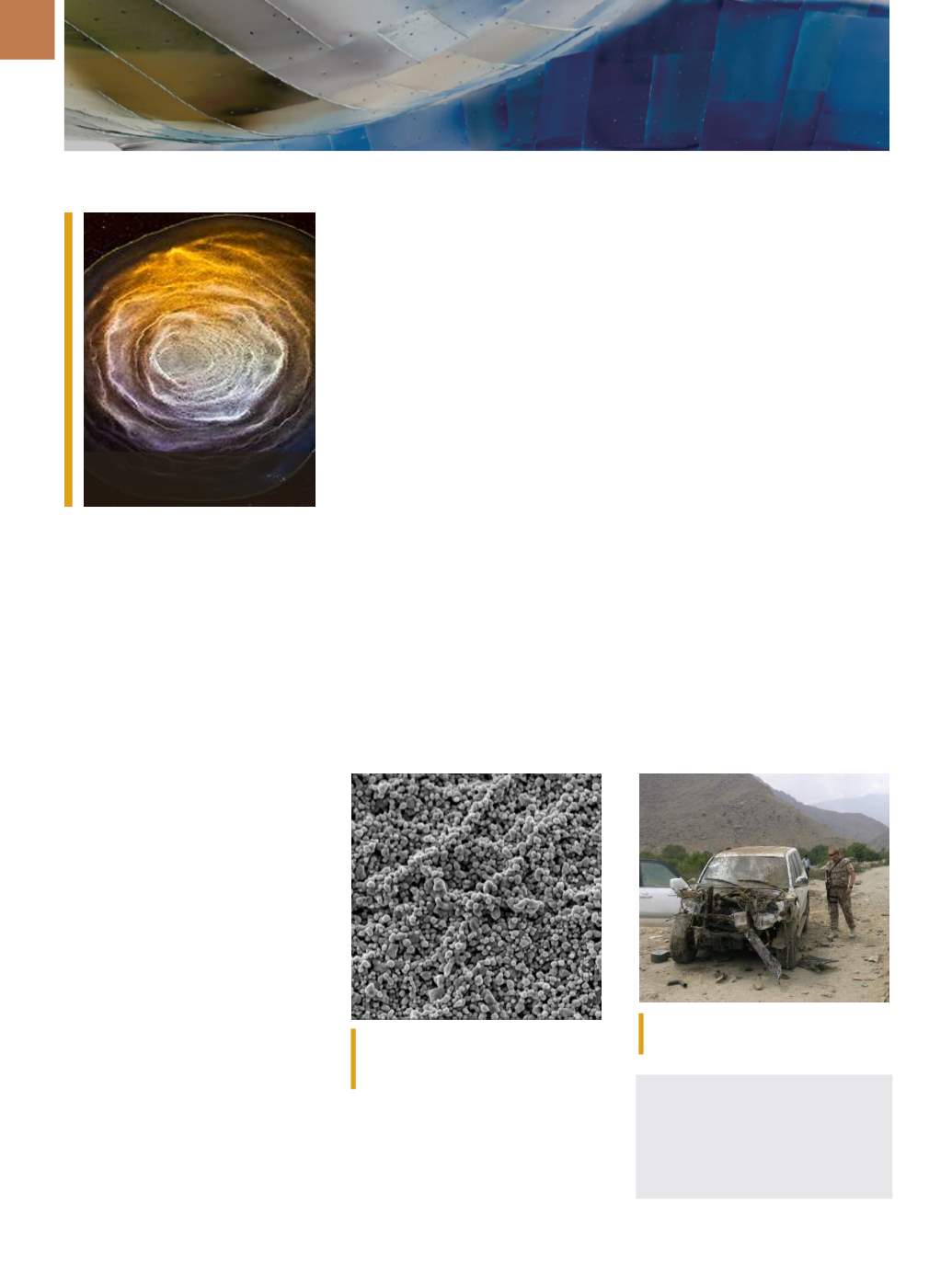

A D V A N C E D M A T E R I A L S & P R O C E S S E S | M A Y 2 0 1 6
8
OMG!
OUTRAGEOUSMATERIALSGOODNESS
RING-FREE WHISKY INSPIRES
NEW COATINGS
Researchers at Princeton Univer-
sity, N.J., with assistance froma photog-
rapher in Arizona, uncovered the secret
behind why whisky does not leave
behind “coffee rings” when it dries. The
team believes their results could lead to
a new type of industrial coating.
Ernie Button, a photographer in
Arizona, noticed that the residue left
behind when whisky dried in a clear
drinking glass was starkly dramatic
when lit frombelowwith various colors.
He teamed up with a group at Princeton
to investigate the phenomenon.
Upon taking a closer look, the
team found two important features in
whiskies that did not leave behind a
coffee ring-type pattern when evapo-
rated. First, they found fat-like mole-
cules that lowered surface tension—as
the liquid evaporated, they collected
on the edges of the drying surface,
which in turn caused a tension gradi-
ent that pulled the liquid back inward.
The second feature was plant-derived
polymers that caused a sticking effect,
which in turn help channel particles in
the liquid to the base material (drinking
glass) where they stay stuck. Research-
ers noted that because of its even
coating distribution characteristics,
Are you working with or have you
discovered a material or its properties
that exhibit OMG - Outrageous
Materials Goodness?
Send your submissions to
Julie Lucko at
julie.lucko@asminternational.org.
Image courtesy of arXiv:1602.07937
[physics.flu-dyn].
Bähring by roadside bomb, Afghanistan
2005. Courtesy of Steffen Bähring/SDU.
whisky-type liquids could be suitable
for industrial coatings or even as a type
of ink for 3D printers.
princeton.edu.
SITTING IN THE SUN COULD
CLEAN YOUR CLOTHES
A spot of sunshine is all it could
take to get your washing done, thanks
to pioneering nanoresearch into self-
cleaning textiles. Researchers at RMIT
University, Australia, developed an
inexpensive and efficient new way to
grow special nanostructures—which
can degrade organic matter when
exposed to light—directly onto tex-
tiles. Rajesh Ramanathan says the pro-
cess has a variety of applications for
catalysis-based industries such as agro-
chemicals, pharmaceuticals, and natu-
ral products, and could be easily scaled
up to industrial levels. “Textiles already
have a 3D structure so they are great at
absorbing light, which in turn speeds
up the process of degrading organic
matter,” he notes.
For more information:
Rajesh Ramanathan,
rajesh.ramanathan @rmit.edu.au,
www.rmit.edu.au.
molecules are in the vicinity. The dis-
covery could improve airport security
and also gives insight into a chaotic
microworld where molecules and
atoms are constantly responding to
their surroundings.
Researchers from the University
of Southern Denmark were inspired by
dogs’ noses, which unlike humans, are
so sensitive that they can detect single
molecules in the air, and are thus valu-
able helpers when it comes to detecting
explosives. Many resources have been
devoted to develop electronic or chem-
ical
noses,
which similarly can detect
explosive molecules.
Researchers created a new mate-
rial that includes the molecules TTF-
C[4]P and TNDCF. TNDCF becomes fluo-
rescent when an explosives molecule is
near. “This knowledge could lead to the
development of a small device which
airport security staff could use to test
if explosive molecules are on or near a
bag,” explains Steffen Bähring.
For more
information: Steffen Bähring,
sbahring@ ifk.sdu.dk,
www.sdu.dk/en.Close-up of the nanostructures grown
on cotton textiles by RMIT University
researchers. Magnified 150,000 times.
NEW MATERIAL SNIFFS
OUT EXPLOSIVES
Scientists created a material
that turns fluorescent when explosive


















